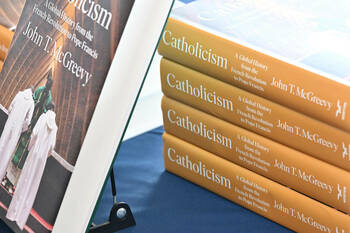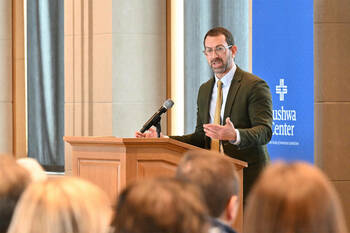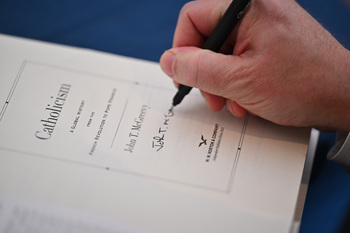Book launch: John T. McGreevy and Samuel Moyn

On Friday, January 27, the university community gathered in the Downes Ballroom in Corbett Family Hall to celebrate the publication of Catholicism: A Global History from the French Revolution to Pope Francis by John T. McGreevy, the Charles and Jill Fischer Provost and Francis A. McAnaney Professor of History at the University of Notre Dame. Kathleen Sprows Cummings welcomed attendees before Elisabeth Köll (William Payden Collegiate Chair and history department chair) offered brief opening comments and introduced featured speaker Samuel Moyn, Chancellor Kent Professor of Law and History at Yale University.
Moyn began by describing the sense of “enormous privilege” he felt in being invited to highlight a work of scholarship—and a scholar—he so admires. He commended the “constantly expanding” range of interests that have marked McGreevy’s career, as his books have moved from a focus on individual cities to a national story, followed by focus on an internationally active religious order, and finally culminating in a global story of a global institution. He also lauded McGreevy’s willingness to tell a story that other scholars have eschewed: “In the profusion of global histories . . . the omission of Catholicism is pretty telling. Why wasn’t it the first topic of the new global history?” Moyn asked rhetorically. In the process of filling that void, McGreevy’s book puts on “a kind of clinic in how one person can take on a global institution and tell its story in synthetic ways,” and Moyn devoted the remainder of his remarks to detailing several lessons he gleaned from that clinic.

Some of Moyn’s observations involved the nuts and bolts of McGreevy’s writing, including the “clear and elegant” prose, the well-constructed, self-contained chapters filled with both well-known and obscure actors, and the range of sites and locations that underscore Catholicism’s global reach while still acknowledging the influence exerted by a “transatlantic core.” Moyn also highlighted McGreevy’s thematic choices, from his consistent attention to the interplay between innovation and tradition to his recognition that Catholicism’s story was never “insular” but always in conversation with surrounding cultures. He praised as well the moral qualities that McGreevy brought to the book, including his foundational “ethical precept” of generously crediting the specialists who have built the field of modern Catholic history and his commitment to writing “with sympathy” about even those historical actors whose opinions McGreevy does not share. Altogether, these many virtues yielded what Moyn called a “magisterial achievement” and a major contribution to the field of global history.

In brief responding remarks, McGreevy opened with expressions of thanks: to his wife, Jean McManus (Catholic Studies Librarian, Hesburgh Libraries); to Moyn for his comments; to Cummings and the Cushwa Center for hosting the gathering; to the librarians who aided his research and the faculty colleagues, including Köll, who critiqued his writing and arguments; and finally to Notre Dame President Rev. John I. Jenkins, C.S.C. He then reflected on the two catalysts behind the book, the first being his conviction about Catholicism’s unique status as a global body: “No institution is as multicultural or multilingual; few touch as many people . . . only the Catholic Church includes extensive networks of people and institutions in Warsaw, Nairobi, and Mexico City, as well as the most remote sections of the Amazon.” Secondly, he quoted Pope Francis to observe that the present moment is not “an era of change, but a change of era.” The 21st century, McGreevy predicted, will witness the “reimagin[ing]” of Catholicism as a global institution, and he hopes that Notre Dame, its people, and even possibly his book might factor into that process of reimagination. The event concluded with a buffet lunch and a book-signing with the author.
Cushwa Center Lecture: Maureen H. O’Connell
On Tuesday afternoon, March 21, La Salle University ethicist Maureen O’Connell delivered the annual Cushwa Center Lecture to a crowd assembled in McKenna Hall. Drawing from her recently published book, Undoing the Knots: Five Generations of American Catholic Anti-Blackness (Beacon, 2022), O’Connell told a story about the “interplay between Irish American Catholicism and anti-Blackness” through the lens of her own family’s arrival to and gradual immersion in greater Philadelphia.
When O’Connell began her research into the topic, she already knew some basics regarding the history of Irish Catholics and race in the United States. She anticipated that she would find evidence of how her Irish ancestors had assimilated to American culture, “becoming white,” she said, and that their assimilation would have occurred “at the expense of others.” She assumed, though, that the process would have lacked “intentionality” and mainly been confined to the initial generation of her immigrant forebears. Instead, what she found were multiple generations engaged in “actively and continually rejecting Blackness and Black people.” The work of “remaining white,” she explained, “is an ongoing project.”
To introduce the audience to that project, O’Connell highlighted three parishes in three historical periods: Christ’s Church (today St. Agnes) in West Chester during the mid-19th century, St. Stephen’s in north Philadelphia during the early 20th century, and St. Francis of Assisi in Norristown during the mid-20th century. Christ’s Church existed only 11 miles north of the Mason-Dixon line in what O’Connell called an “emancipation borderland,” a vital hub on the Underground Railroad and a site of regular tension “between abolitionists, free black people, and southern slave-owners and slave-catchers.” Yet all this local flux does not appear in the Christ’s Church historical record, a fact O’Connell attributed in part to resistance by certain contemporary Catholic leaders. The Irish-born Bishop of Philadelphia, Francis Patrick Kenrick (c. 1797–1863), viewed chattel slavery not as an institution to overthrow but as a structure to work within, focusing his efforts on strategies for catechizing enslaved populations rather than arguments for emancipation. “In Kenrick,” O’Connell observed, “we learn that proximity to positions of power exercised over others obfuscates the possibilities of building power with others.”
From the outlying area of Chester County, O’Connell moved to St. Stephen’s in the heart of north Philadelphia, highlighting how Catholics like Cardinal Dennis Dougherty (1865–1951) sought to use the national sesquicentennial celebration in 1926 to, in O’Connell’s words, “publicly attest to Catholic alignment” with the country. At the time, that meant alignment with white Christianity, a categorization that had often excluded Catholics whom many Americans suspected would “dilute the native Protestant ethos” of the country. If public homilies and other pronouncements during the sesquicentennial took pains to argue that Catholics could act out their fervent patriotism while fully retaining their religious distinctives, Catholic participation in the festivities also demonstrated what O’Connell deemed “implicit compliance” with white supremacy. When three women from St. Peter Claver, the city’s first Black parish, twice wrote to Cardinal Dougherty regarding participation in an upcoming Catholic sesquicentennial exhibit, they were ignored; at the bottom of their second letter, his secretary wrote, “the Archbishop does not intend to take a hand in this matter.”
O’Connell’s account of St. Francis of Assisi was her most personal, as it dealt with her maternal grandparents and her mother. Archival research had led her to discover a 1950 news clipping from the Norristown Times Herald titled “‘Minstrel Time’ Presented By St. Francis School Pupils,” describing a St. Patrick’s Day event the day prior with her mother and uncle listed as performers. Early American minstrel shows, as performed by Protestants, had often linked Black and Irish Americans as equally worthy of mockery, but over time Irish immigrants themselves appropriated the minstrel show, and their performances conveyed a distinction between Irish traits as “fitting for America” versus the “permanent otherness” of Black Americans. The minstrel show at St. Francis of Assisi was hosted in the parish hall, “the place where social capital was continually generated in the parish,” making clear that Catholic Philadelphia was “white territory” to be entered only on white Catholic terms. All this evidence persuaded O’Connell of the stubbornness of these “Celtic knots” of anti-Blackness and of the urgency to “excavate this history and [to] name it.”
O’Connell then engaged the audience in a discussion about the lecture. Tom Kselman (history emeritus) asked whether Catholic anti-Blackness frequently occurred through “crude public articulation” or more often via subtle language and behavior. While the latter was most common, O’Connell referenced evidence she had uncovered of explicit racism in a Jesuit parish in north Philadelphia attended by her paternal great-grandparents. Peter Cajka (American studies) asked O’Connell to reflect on the methodological challenges she faced trying to write academically about something as personal and sensitive as family history. O’Connell cited lessons she has gleaned from community organizers in their application of anti-racist praxis. The sharing of “story,” she asserted, is “the most compelling thing that you can do to build power.” Finally, Deacon Mel Tardy (Center for University Advising) thanked O’Connell and tied her findings to current events, including Catholic spaces where Black presence is still unwelcome—O’Connell agreed, noting that as recently as 2020, some participants wore Blackface during Philadelphia’s annual New Year’s Day Mummers Parade. After O’Connell’s closing comment, Cushwa Center director Kathleen Sprows Cummings thanked O’Connell for the lecture and encouraged all those in attendance to continue discussing themes of Catholic identity and anti-racism.
Seminar in American Religion: Kathryn Gin Lum
The Cushwa Center hosted its semiannual gathering of the Seminar in American Religion on Saturday morning, April 15, when attendees convened in McKenna Hall to discuss Kathryn Gin Lum’s Heathen: Religion and Race in American History (Harvard, 2022). After greeting the audience, Kathleen Sprows Cummings opened the morning by introducing the seminar’s two commentators, Emily Clark (Gonzaga University) and Korey Garibaldi (Notre Dame).
Clark spoke first and began by describing how the book had forced her to reconsider her own scholarship and the larger field of American religious history. The theme from Heathen which most stood out to Clark was the significance of “language and its relationship to materiality.” If scholars in communication studies first showed how language both mediates and creates knowledge of the world, Gin Lum’s book took that insight a step further, proving that “ideas and materiality go hand-in-hand.” While language frequently creates in-groups and out-groups, that dynamic assumes special import when wielded by those with social power. The “cultish” behavior evinced by practitioners of CrossFit, for example, matters less than the binary between the heathen and the righteous. In Clark’s summary, the book persuaded her that “language plus power can equal social or physical death.” One of Clark’s remaining questions after completing Heathen—which largely emphasized white Protestants—was how these dynamics have played out among Catholics.
Next, Garibaldi prefaced his remarks with gratitude for being part of the conversation; before accepting his faculty appointment at Notre Dame, Garibaldi had done little reading in American religion, but books like Gin Lum’s have now transformed his interpretations of U.S. history. He commended the book’s range, both chronologically as its “extraordinary timespan” covered content from ancient Greece to the COVID-19 pandemic and geographically as Gin Lum’s sources enabled her to tell a “truly global history.” Garibaldi especially appreciated the treatment of those figures, such as David Walker and Frantz Fanon, who reappropriated the term and interpreted “heathen” culture as a standing rebuke against the depravities of white Christianity. Like Clark, Garibaldi wondered whether future scholarship might apply the same categories of critique to U.S. Catholics, whose historical exclusion of Black Americans was no less intentional or concerted.
In response, Gin Lum thanked the Cushwa Center and both commentators for the chance to discuss her work. She affirmed Garibaldi’s observation that the book—in the writing as well as in the reading—was a “hard history,” one she was inspired to pursue in part by her own experience as an insider-outsider: “an outsider to whiteness,” but (in her youth) an insider to the type of church communities she describes. She also agreed with Clark regarding the central role of language in the book’s narrative, citing the prior work of scholars such as Charles Long and Sylvester Johnson. She views Heathen as a work of synthesis “trying to bring that scholarship together.” To the questions regarding Catholics, Gin Lum described how context often shaped the facts. In some cases, Protestant observers believed Catholics were too quick to accept conversion, a posture that allowed for the continuation of “heathen” practices; in others, Catholics seemed more inclined than Protestants to believe certain peoples fundamentally incapable of shedding their heathenness. That was not necessarily a point in Protestants’ favor, however, as the notion of “changeability” was often used to “rationalize colonization and all of its attendant brutalities.”
After a coffee break, the seminar resumed for a time of questions and answers. Tom Kselman (Notre Dame) opened proceedings with a tribute to outgoing director Kathleen Sprows Cummings, praising her leadership of the center’s programming, her work in extending the center’s global partnerships, her mentorship of junior scholars, and her scholarship on and elevation of issues related to women, gender, and power.
Several scholars then asked questions regarding Gin Lum’s approach to emphasizing historical continuity rather than change. Darryl Hart (Hillsdale College) wondered whether attention to change over time might have clarified important differences between, for example, missionaries active during the early American republic and those operating as proxies of the New Imperialism, and Mary Cayton (Miami University, emeritus) praised Gin Lum’s book while also challenging the assertion that continuity rather than change has marked the period following 1960. Gin Lum answered these interlocutors in detail, while in each case acknowledging the rhetorical intentionality behind her narrative decisions. “Focusing primarily on change lets too much off the hook,” she said, explaining that she wished to challenge readers with details of continuity.
Another batch of participants posed questions about terminology: Emily Conroy-Krutz (Michigan State University) asked if it matters that missionaries not only used “heathen” as a catch-all designation but also theorized “hierarchies of heathenism” involving degrees of changeability; Tom Tweed (Notre Dame) addressed the book’s approach to the broad concepts of “race” and “religion”; and David Lantigua (Notre Dame) discussed the “fluid” nature of heathen as a category and especially its “reflexive” embrace by certain characters in the book. Gin Lum affirmed these questions, repeatedly highlighting the subject matter’s complexity. She described how workshopping prior drafts of the book had guided her approach to questions of “lumping or splitting” various heathen subgroups. She also recounted her experiences translating her research about religion to historians who are often skeptical of its significance, and she analyzed the rise of terms such as “ethnic” or “Black Indigenous People of Color (BIPOC)” as potential new manifestations of a “tradition of . . . reclaiming in this kind of reflexive way the notion of ‘heathen’ as a lumping category that is not something to be ashamed of.” With these and many more questions filling 90 minutes of vibrant discussion, Cummings finally closed the session by thanking Gin Lum and encouraging attendees to return in the fall for the next iteration of the seminar.
Philip Byers is a postdoctoral research associate at the University of Notre Dame’s Cushwa Center.